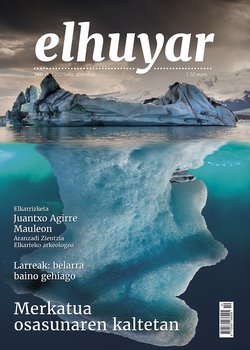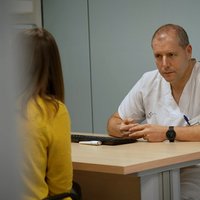White vultures in danger
With the arrival of spring, members of the Association for the Study of Predatory Birds usually climb the mountain from weekend to weekend, chasing the white vines. These little scavengers of the vulture family usually arrive in February from Africa to nest in our territory. Each pair usually lays two eggs, but in most cases, only one of them comes out ahead. One of the tasks of this non-governmental organization is to monitor the reproduction of the White Vulture to determine whether the populations have been maintained or not. In fact, the white vulture is in danger.
By Ainara Azkona; SEAR: The species is in danger. The population of Biscay is not so bad, but in any case, it has many problems. The most serious problems are usually the inconvenience caused to the nests. For example, Bizkaia is a very populated place and there are many people everywhere. Because the white vultures are very frightened, when people approach them they do not enter the nest and do not give food to the chick. If this happens a lot when the cock is small, the cock can starve to death.
Today, Iñigo Zuberogoitia will descend from this rock of Mugarra to the nest. It should be kept in the nest for as little time as possible so as not to cause inconvenience to the bird.
Using a rope, they send him a rubber bag to put the cock inside.
they put the rings on the chicks when they're about 50 days old. They don't know how to fly yet, but they're big enough to safely leave the nest.
By Ainara Azkona; SEAR: We take the cock and the first thing we do is ring it. On the one hand, we put the official ring of Aranzadi on it. On the other hand, we put a colored ring on it. This is very important because it can be seen from a distance. For example, this animal, when it leaves the nest, will rest on a rock, and someone can see it through a telescope. Then we can track him through the ring. So we don't have to catch that animal again and wait for it to die.
By Ainara Azkona; SEAR: After the annulment, we take biometric measurements. We take a few precautions to the chicks: the length of the lumen, the tart (because the first thing that the birds grow is the tart), the length of the head and the beak...
By Ainara Azkona; SEAR: Then we take blood from the chick... and we store it in two places: on the one hand, we keep it with alcohol for a little while and with it we do sex, through genetics.
This information will allow them to find out, one day, whether it is male or female, by observing the dimensions of the bird.
Once the weight of the bird has been measured, it is returned to the nest in the same bag. With all the data collected, they closely monitor the white vulture population. Not only that: all these data serve to know the problems that the species has. If you don’t want to lose the white vulture, you need to know as much as possible about it.
By Ainara Azkona; SEAR: The investigation is important because the white vulture is in danger. And our population in Bizkaia is not as bad as in other places. For this reason, it is very important to know what the problems are in a population that is not so bad to help in other places. We can know what the underlying problems are and what the measures should be.
The SEAR association was formed in 1999. They study not only the white vines, but also the brown vulture, the big hawk and many other species. Some of the members of the association are biologists; others are aviators. All of them, volunteers.
At the end of August, the white vultures leave for Africa with rings on their legs. If all goes well, the families will come back next year to expand.
Buletina
Bidali zure helbide elektronikoa eta jaso asteroko buletina zure sarrera-ontzian











